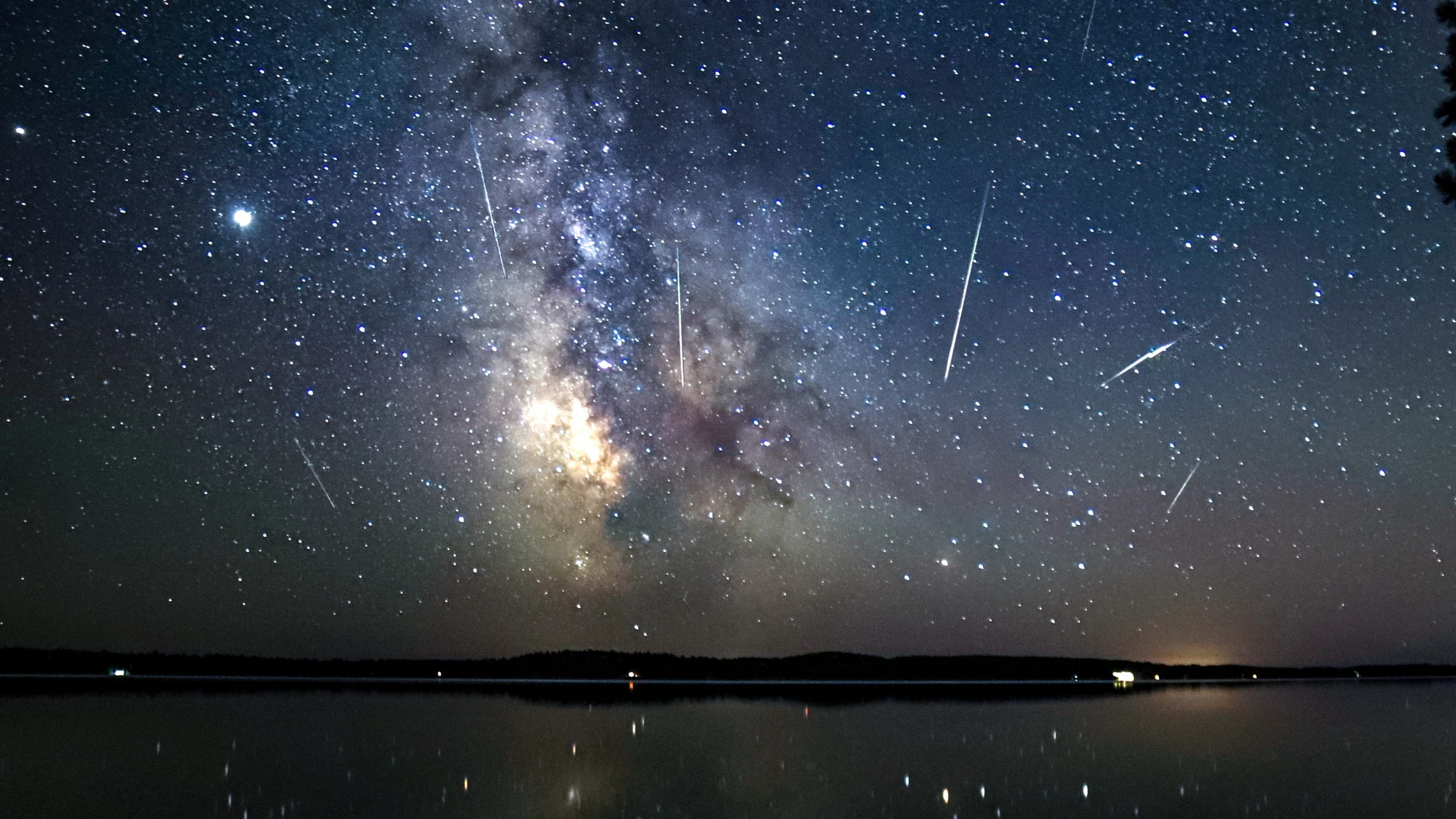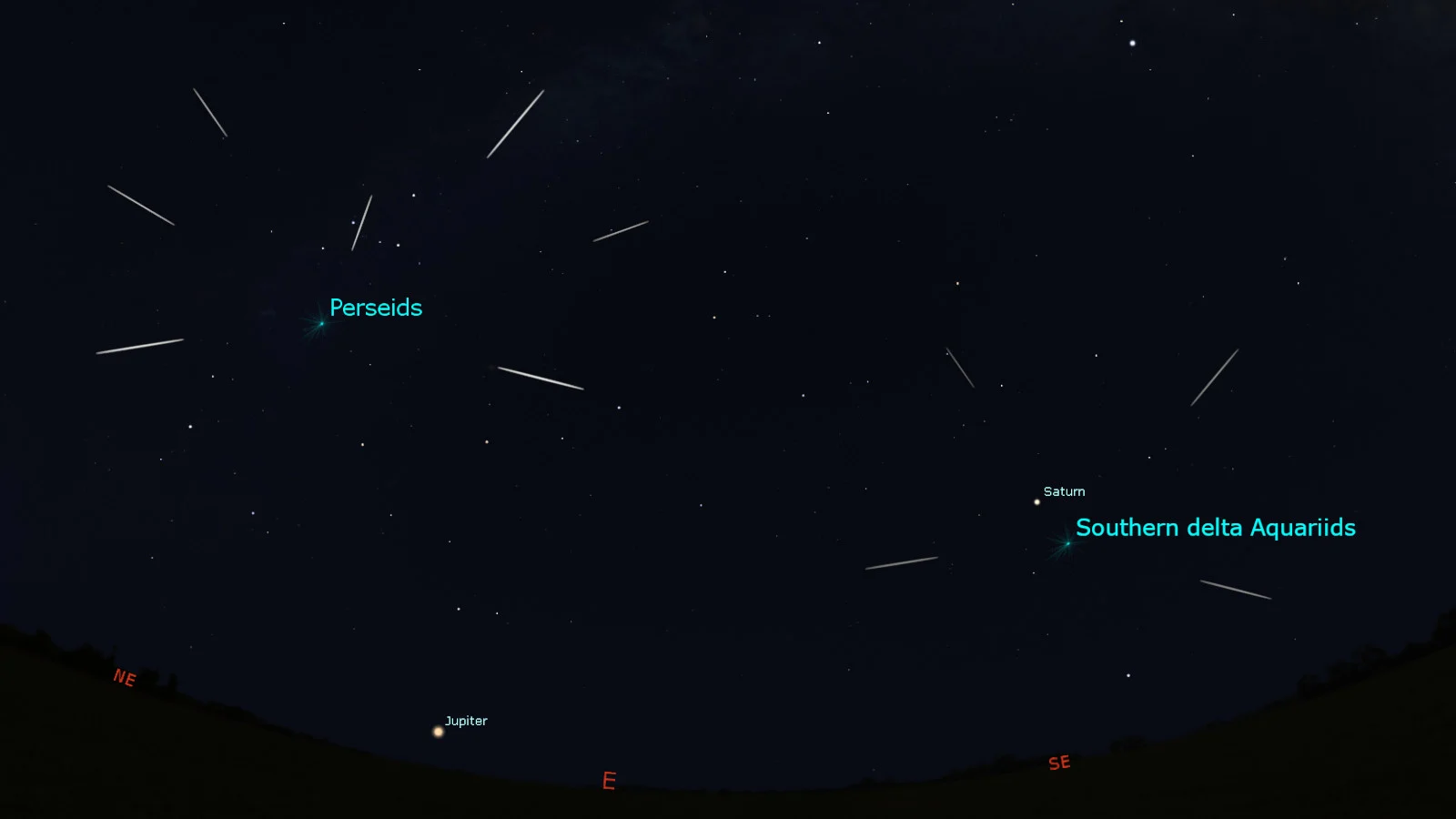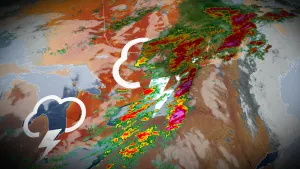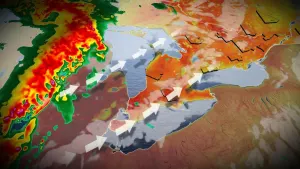
See two summer meteor showers light up the night this weekend
Two of the best summer meteor showers are active right now, with one peaking during the last weekend of July.
Check your weather forecast and hope for clear skies this weekend, as you may see meteors from two different celestial objects zipping by overhead.
On the nights of July 29 and 30, the annual southern delta Aquariid meteor shower will be reaching its peak, sending streaks of light across our night sky.
Southern delta Aquariid meteors are thought to originate from an object known as 96P/Machholz. This sun-grazing comet takes a little over five years to complete an orbit and is known for having one of the closest close approaches to the Sun for a comet of its type. When Earth passes through the comet's orbit, from July 12 to August 23 each year, bits of ice and dust streak through the upper atmosphere, producing bright flashes of light that we call meteors.
Remarkably, astronomers have measured the chemical composition of 96P/Machholz from the light the comet's nucleus reflects. What they found is it may have originated from beyond our solar system. Thus, while we don't know for certain, the southern delta Aquariids may be an alien meteor shower!
Throughout the event, the number of meteors increases towards the end of July and then diminishes again through August. During the peak, stargazers can spot about a dozen or more meteors per hour. The greatest number is typically seen in the hours before sunrise on the mornings of July 29 and July 30.

Southern delta Aquariid meteor shower radiate out from a point in the sky near the constellation Aquarius, in the southeastern sky, at around 1 a.m. local time on July 29, while Perseid meteors streak out of the northeast. Credit: Stellarium/Scott Sutherland
At the same time, the famous Perseid meteor shower — one of the best astronomical events of the year — will be building towards its own peak in August.
Originating from comet 109P/Swift-Tuttle, the Perseids have such an excellent reputation for two reasons: It is only one of three meteor showers during the year that regularly produces up to 100 meteors per hour during its peak, and it is well-known for producing the most bright fireballs than any other meteor shower we see during the year.
The peak of the Perseids occurs on the night of August 12-13, and according to the Canadian Space Agency: "During the peak, typically in the darkest hours after midnight, up to 50 to 80 meteors per hour can streak across the sky. To be even more specific, look up at the sky between moonset and dawn to see the most meteors of the night."
However, the Perseids can still produce between 15-20 meteors per hour, even two weeks before that. If skies are clear, this could more than double the number of meteors we see during the southern delta Aquariids peak.
Besides the sky conditions, the other limiting factor for meteor-gazing this weekend is the nearly-Full Moon. With the Super Sturgeon Moon (the first of two August Full Moons) set to rise on Tuesday night, the sky will be awash with bright moonlight.
Fortunately, since southern delta Aquariid and Perseid meteors can flash through the sky anywhere overhead, skywatchers can turn their back to the Moon to preserve their night vision. Read on for more tips on watching meteor showers.
--
DON'T MISS: A super-rare Perigee Blue Moon lights up the night sky this summer
--
Getting the most out of a meteor shower
Meteor showers are events that nearly everyone can watch. No special equipment is required. In fact, binoculars and telescopes make it harder to see meteor showers, by restricting your field of view. However, there are a few things to keep in mind so you don't miss out on these amazing events.
The three best practices for observing the night sky are:
Check the weather,
Get away from light pollution, and
Be patient.
Clear skies are essential. Even a few hours of cloudy skies can ruin your chances of watching an event such as a meteor shower. So, be sure to check The Weather Network on TV, on our website, or from our app, and look for my articles on our Space News page, just to be sure that you have the most up-to-date sky forecast.
Next, you need to get away from city light pollution. If you look up into the sky from home, what do you see? The Moon, a planet or two, perhaps a few bright stars such as Vega, Betelgeuse and Procyon, as well as some passing airliners? If so, there's too much light pollution in your area to get the most out of a meteor shower. You might catch an exceptionally bright fireball if one happens to fly past overhead, but that's likely all you'll see. So, to get the most out of your stargazing and meteor watching, get out of the city. The farther away you can get, the better.
Watch: What light pollution is doing to city views of the Milky Way
For most regions of Canada, getting out from under light pollution is simply a matter of driving outside of your city, town or village until a multitude of stars is visible above your head.
In some areas, especially in southern Ontario and along the St. Lawrence River, the concentration of light pollution is too high. Getting far enough outside of one city to escape its light pollution tends to put you under the light pollution dome of the next city over. The best options for getting away from light depend on your location. In southwestern Ontario and the Niagara Peninsula, the shores of Lake Erie can offer some excellent views. In the GTA and farther east, drive north and seek out the various Ontario provincial parks or Quebec provincial parks. Even if you're confined to the parking lot after hours, these are usually excellent locations from which to watch (and you don't run the risk of trespassing on someone's property).
If you can't get away, the suburbs can offer at least a slightly better view of the night sky. Here, the key is to limit the amount of direct light in your field of view. Dark backyards, sheltered from street lights by surrounding houses and trees, are your best haven. The video above provides a good example of viewing based on the concentration of light pollution in the sky. Also, check for dark sky preserves in your area.
When viewing a meteor shower, be mindful of the phase of the Moon. Meteor showers are typically at their best when viewed during the New Moon or Crescent Moon. However, a Gibbous or Full Moon can be bright enough to wash out all but the brightest meteors. Since we can't get away from the Moon, the best option is just to time your outing right, so the Moon has already set or is low in the sky. Also, you can angle your field of view to keep the Moon out of your direct line of sight. This will reduce its impact on your night vision and allow you to spot more meteors.
Once you've verified you have clear skies and you've limited your exposure to light pollution, this is where being patient comes in.
For best viewing, your eyes need some time to adapt to the dark. Give yourself at least 20 minutes, but 30-45 minutes is best for your eyes to adjust from being exposed to bright light.
Note that this, likely more than anything else, is the one thing that causes the most disappointment when it comes to watching a meteor shower.
If you step out into your backyard from a brightly lit home and looking up for a few minutes, you might be lucky enough to catch a rare bright fireball meteor. However, it's far more likely that you won't see anything at all. Meteors may be streaking overhead, but it takes time for our eyes to adjust, so that we can actually pick out those brief flashes of light. Waiting for at least twenty minutes, while avoiding sources of light during that time (streetlights, car headlights and interior lights, and smartphone screens) dramatically improves your chances of avoiding disappointment.
Sometimes, avoiding your smartphone isn't an option. In this case, set the display to reduce the amount of blue light it gives off and reduce the screen's brightness. That way, it will have less of an impact on your night vision.
You can certainly gaze into the starry sky while you are letting your eyes adjust. You may even see a few of the brighter meteors as your eyes become accustomed to the dark.
Once you're all set, just look straight up and enjoy the view!
--
(Thumbnail image courtesy Graham Fielding Photography, who uploaded the image into The Weather Network's UGC gallery.)










